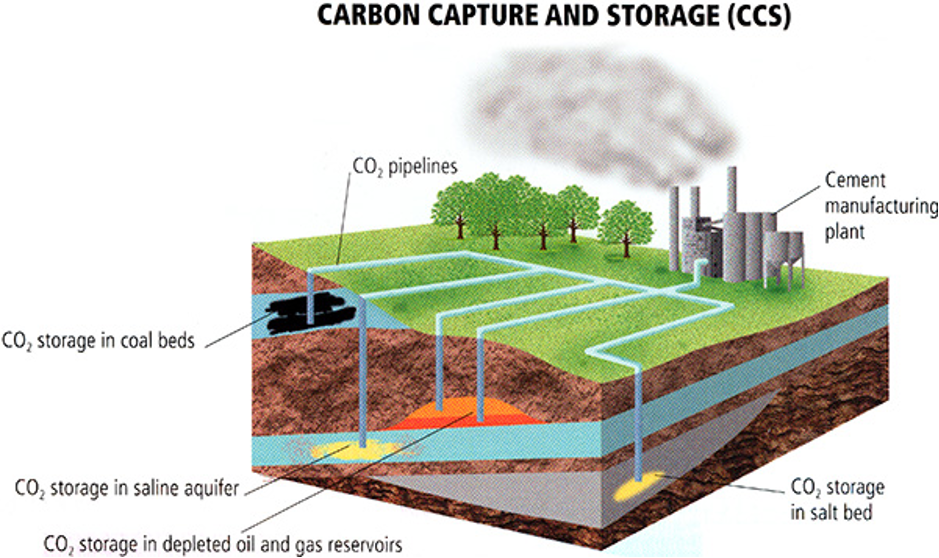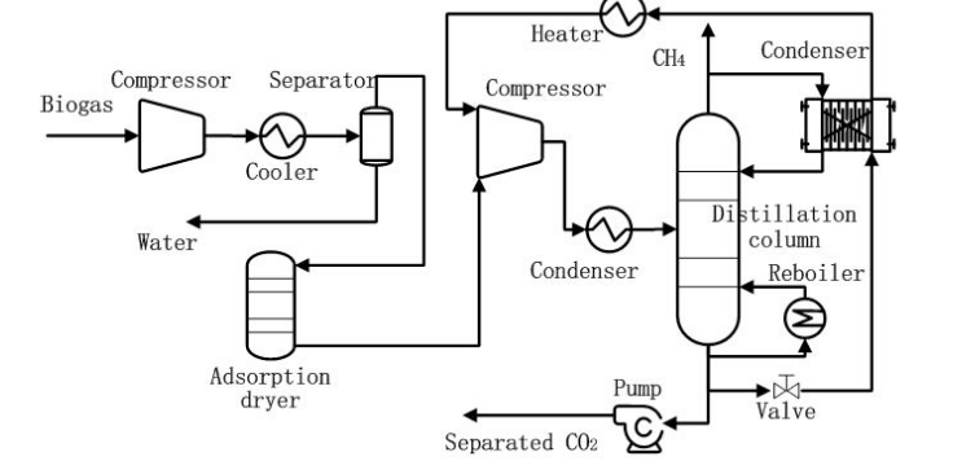Many technologies can be applied to separate the from the flue gas stream at the high purity required for sequestration. The choice of the technology for the process will specifically depend on the conditions of the flue gas stream. This purity level is needed as well as the implementation cost and flexibility. Therefore, this report will focus on three main types (Sarwer et al.,2022). Carbon Capture and storage, Cryogenic Separation, and membrane Separation as the candidate methods used in the Separation of . The technologies will be further evaluated based on their economic, environmental, and safety suitability; the most suitable technology will be.
Carbon Capture and Storage (CCS)

Carbon Capture and Storage (CCS) is a technology that separates from flue gas streams and stores it in underground geologic formations. The most common method in CCS is called post-combustion capture, where the flue gas is through an amine-based solvent that absorbs the (Carbon capture and sequestration. Carbon Capture and Sequestration). The is then released from the solvent and compressed for storage. CCS is a well-established technology used in several pilot and commercial projects. However, it is energy-intensive and can increase the cost of power generation.
Cryogenic Separation

Cryogenic Separation is another alternative technology that can separate from flue gas streams. This method uses the difference in boiling points between and other gases in the stream to separate them. The flue gas is cooled to a shallow temperature, causing the to condense and separate from the other gases (Cryogenic Separation. Cryogenic Separation – an overview | ScienceDirect Topics). Cryogenic Separation is a highly efficient method of Separation, but it requires large amounts of energy and can be expensive to operate.
Membrane Separation

Membrane separation is a third alternative technology for Separation from flue gas streams. This method uses a selective membrane to separate the from other gases in the stream. The flue gas is through the membrane, which only allows the to pass through while retaining other gases (Ji & Zhao, 2017). Membrane separation is a relatively new technology and is still in the research and development stage. It has the potential to be a cost-effective and energy-efficient method of Separation, but more research is needed to improve the performance of the membranes.
Different selection criteria to propose to judge the technology candidates
Several criteria for selection can be used in evaluating the various technology candidates that will be used in the Separation of from flue gas streams at the high purity required for sequestration. That is in terms of the economic, environmental, and safety of the candidate technology and their suitability to have the stated problem.
Various factors can be considered based on their economic output, such as capital costs, operation costs, and revenue incurred. The capital cost, which is the initial cost of building and installing the equipment required for the technology, is crucial for assessing the technology (Rahimi et al.,2022). It includes the cost of materials, construction, and any necessary permits or licenses. It is significant since it helps in deciding which technology to use that will fit the required budget of the project.
The ongoing cost of running the technology, including labor, energy, and maintenance, is the operation cost. While revenue denotes the potential revenue from selling the captured , such as for use in enhanced oil recovery or in the production of commercial products (Rahimi et al.,2022). The cost of operation and revenue also helps make decisions based on the technology that fits the required project budget without going at any loss.
Based on the environmental criteria of the candidate technologies, it is best to consider greenhouse gas emissions and waste generation. Greenhouse gas emissions revolve around the total emissions of greenhouse gases, including , associated with the technology throughout its lifecycle, from the extraction and processing of raw materials to the disposal of waste (Tsouris, Moline & Aaron,2022). Waste generation also revolves around the amount and type of waste the technology generates. It is significant to base the candidate technologies on the environmental aspect, that is, to prevent future effects on the ozone layer, as well as come up with suitable ways to prevent the environment from being damaged.
While assessing the candidate technologies based on the safety criteria of the technology, it is significant to consider Occupational health and safety, which is the risk to workers involved in the operation and maintenance of the technology. The risk of accidents denotes the likelihood of accidents occurring during the operation of the technology (Sodiq et al.,2022). Furthermore, emergency response is the ability of the technology to respond to and manage emergencies, such as equipment failure or chemical spills.
Other Relevant Criteria that can assess the technologies are Scalability which is the technology’s ability to be scaled up or down to meet changing demands. Reliability denotes the technology’s reliability in terms of its ability to operate consistently and effectively over time (Sodiq et al.,2022). Maintenance is the technology’s ease of maintenance and the required maintenance frequency. Furthermore, durability is the expected lifespan of the technology.
Performance evaluation of Carbon Capture and Storage (CCS)
Economically, CCS is currently considered a costly technology. The cost of capturing and storing can be significant, and this has limited the deployment of CCS to a small number of pilot projects. However, as the technology matures and economies of scale, the cost of CCS is expected to decrease. From an environmental perspective, CCS is a promising method for reducing greenhouse gas emissions (Carbon capture and sequestration. Carbon Capture and Sequestration). By capturing and storing , CCS can help mitigate climate change’s effects. However, the effectiveness of CCS in reducing emissions depends on the ability to capture and store a significant portion of CO2 emissions, which is currently a challenge. The safe storage of underground is crucial to prevent leaks, which could negatively impact human health and the environment.
Performance evaluation of cryogenic Separation
Economically, cryogenic Separation is to be a relatively expensive method for separating gases. The cost of cooling gases to such low temperatures and maintaining the necessary equipment can be high. However, the cost of cryogenic Separation has decreased over time as the technology improves and economies of scale. From an environmental perspective, cryogenic Separation is considered a relatively low-impact method for separating gases (Cryogenic Separation. Cryogenic Separation – an overview | ScienceDirect Topics). Additionally, cryogenic Separation can separate gases for clean energy production. The low temperatures in the process can present hazards such as frostbite and asphyxiation. Additionally, the equipment used in cryogenic Separation must be adequately maintained to prevent leaks or other incidents.
Performance evaluation of membrane separation
Economically, membrane separation is a relatively cost-effective method for separating gases and liquids. The cost of the membrane material and the equipment required for the process are relatively low, and the process itself is relatively simple. Additionally, the energy requirements for membrane separation are often low, which can further reduce the cost of the process (Ji & Zhao, 2017). From an environmental perspective, membrane separation is a relatively low-impact method for separating gases and liquids. The process does not involve using chemicals or other hazardous materials and produces minimal emissions. The process is relatively safe, and the equipment used in membrane separation is typically not hazardous. However, safety risks can be present if the membrane is not properly maintained, leading to leaks or other incidents.
Decision Matrix
A decision matrix is a tool to evaluate and compare different options based on criteria. In this case, the options are Carbon Capture and Storage (CCS), Cryogenic Separation, and Membrane Separation, and the criteria are economic, environmental, and safety suitability. The matrix and ranking on the assumption that the given ratings and weighting accurately represent the technology’s performance and importance.
| Economic suitability | Environmental suitability | Safety suitability | Overall score | |
| Carbon Capture and storage | 4 | 5 | 4 | 23 |
| Cryogenic Separation | 3 | 4 | 3 | 14 |
| Membrane separation | 5 | 3 | 5 | 24 |
The overall ranking of the candidate technologies:
- Membrane Separation
- Carbon Capture and Storage
- Cryogenic Separation
Recommendations
The matrix suggests that Membrane Separation is the best option based on the overall score. This technology scored the highest in economic suitability, safety suitability, and overall score. It is more energy efficient and less expensive than other separation methods, making it a more economically suitable option. Additionally, it has high safety suitability as it does not require high-pressure or high-temperature conditions and is considered less risky than other technologies (Ji & Zhao, 2017). However, it is essential to note that the environmental suitability is lower than the other technologies, CCS and Cryogenic Separation. Therefore, it is essential to consider the environmental impact of the technology before making a final decision. This technology is known for its energy-efficient and cost-effective nature and is also very safe to operate. Therefore, Membrane separation is the best technology among the three.
References
Carbon capture and sequestration. Carbon Capture and Sequestration | METEO 469: From Meteorology to Mitigation: Understanding Global Warming. (n.d.). Retrieved January 17, 2023, from https://www.e-education.psu.edu/meteo469/node/223Top of Form
Cryogenic Separation. Cryogenic Separation – an overview | ScienceDirect Topics. (n.d.). Retrieved January 17, 2023, from https://www.sciencedirect.com/topics/engineering/cryogenic-separation#:~:text=Cryogenic%20separation%20involves%20cooling%20the,to%20operate%20the%20refrigeration%20unit.Bottom of Form
Ji, G., & Zhao, M. (2017, March 8). Membrane separation technology in Carbon Capture. IntechOpen. Retrieved January 17, 2023, from https://www.intechopen.com/chapters/53169
Rahimi, M., Khurram, A., Hatton, T. A., & Gallant, B. (2022). Electrochemical carbon capture processes for mitigation of CO 2 emissions. Chemical Society Reviews.
Sarwer, A., Hamed, S. M., Osman, A. I., Jamil, F., Al-Muhtaseb, A. A. H., Alhajeri, N. S., & Rooney, D. W. (2022). Algal biomass valorization for biofuel production and carbon sequestration: a review. Environmental Chemistry Letters, 1-55. https://link.springer.com/article/10.1007/s10311-022-01458-1
Sodiq, A., Abdullatif, Y., Aissa, B., Ostovar, A., Nassar, N., El-Naas, M., & Amhamed, A. (2022). A review on progress made in direct air capture of CO2. Environmental Technology & Innovation, 102991.
Tsouris, C., Moline, G., & Aaron, D. S. (2022). Separation of CO2 from Flue Gas and Potential for Geologic Sequestration (No. ORNL/TM-2022/2790). Oak Ridge National Lab.(ORNL), Oak Ridge, TN (United States).
 write
write